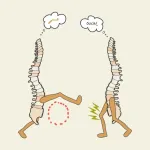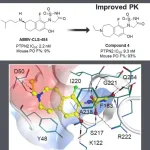(Press-News.org) Shedding light on why some massive stars have magnetic fields even though these stars’ interiors layers don’t undergo convection, researchers report observational evidence that magnetic fields form in some such stars through stellar mergers. The magnetic fields of low-mass stars, like the Sun, are produced by a dynamo generated in the convective layers of the star’s interior. Massive stars – those 8 or more solar masses at formation – do not have the convective interiors required to sustain magnetic fields in this way. However, roughly 7% of massive stars have been observed to have magnetic fields, the origin of which is poorly understood. Several mechanisms have been proposed. One possibility is that the magnetic fields could arise through mixing of stellar material, such as during a stellar merger. Here, Abigail Frost and colleagues present multi-epoch interferometric and spectroscopic observations of HD 148937, a binary system consisting of two massive stars surrounded by a bipolar nebula. Frost et al. monitored the binary system for 9 years, allowing them to determine its orbit and the properties of the constituent stars. They find that only one of the two stars is magnetic and that it appears to be younger than its companion. Using these data and theoretical models, the authors characterize the system’s evolution and conclude that the HD 148937 originally contained at least three stars; a stellar merger between two of the stars, which likely occurred only a few thousand years ago, produced the magnetic field in the merged star, and made it appear younger than its current binary companion. The same merger might also have produced the bipolar nebula surrounding the system. According to Frost et al., their inferred history of this system provides observational support for the proposal that stellar mergers produce magnetism in at least some massive stars.
END
A magnetic massive star was produced by a stellar merger
2024-04-11
ELSE PRESS RELEASES FROM THIS DATE:
Thin oil films enable stable oil and water mixtures sans surfactant
2024-04-11
Thin oil films absorbed onto the surface of water droplets lead to anomalously stable, surfactant-free oil and water mixtures, according to a new study. The findings demonstrate a mechanism for stabilizing water droplets in a water-oil emulsification without the need for a surfactant, which could have important technological applications, including the creation of very pure and controlled materials. Oil and water cannot form homogenous mixtures. Instead, when combined, droplets of one fluid will disperse inside the other, forming ...
*FREE* Growing tribal clean energy in the US
2024-04-11
New US federal legislation sets aside nearly $14 billion for 574 federally recognized indigenous nations and villages, which can be used to support tribal climate responsiveness and energy sovereignty. In a Policy Forum, Kimberly Yazzie and colleagues present a roadmap for designing, implementing, and funding projects and people to accelerate the renewable energy transition while also benefiting the indigenous entities involved. According to the authors, this opportunity positions indigenous communities to develop their economies and energy projects ...
The nitroplast revealed: a nitrogen-fixing organelle in a marine alga
2024-04-11
A nitrogen-fixing bacterial endosymbiont of marine algae is evolving into a nitrogen-fixing organelle, or nitroplast, according to a new study, thereby expanding a function that was thought to be exclusively carried out by prokaryotic cells to eukaryotes. Eukaryotic cells are remarkably complex and contain various organelles, which are specialized structures within a living cell that have specific biological functions. Two organelles, mitochondria and chloroplasts, play a key role in energy metabolism and ...
First step to untangle DNA: supercoiled DNA captures gyrase like a lasso ropes cattle
2024-04-11
Picture in your mind a traditional “landline” telephone with a coiled cord connecting the handset to the phone. The coiled telephone cord and the DNA double helix that stores the genetic material in every cell in the body have one thing in common; they both supercoil, or coil about themselves, and tangle in ways that can be difficult to undo. In the case of DNA, if this overwinding is not dealt with, essential processes such as copying DNA and cell division grind to a halt. Fortunately, cells have an ingenious solution to carefully regulate DNA supercoiling.
In this study published in the journal Science, researchers ...
Brainless memory makes the spinal cord smarter than previously thought
2024-04-11
Aya Takeoka at the RIKEN Center for Brain Science (CBS) in Japan and colleagues have discovered the neural circuitry in the spinal cord that allows brain-independent motor learning. Published in Science on April 11, the study found two critical groups of spinal cord neurons, one necessary for new adaptive learning, and another for recalling adaptations once they have been learned. The findings could help scientists develop ways to assist motor recovery after spinal cord injury.
Scientists have known for some time that motor output from the spinal cord can be adjusted through practice ...
Study reveals giant store of global soil carbon
2024-04-11
Soil carbon usually refers only to the organic matter component of soils, known as soil organic carbon (SOC). However, soil carbon also has an inorganic component, known as soil inorganic carbon (SIC). Solid SIC, often calcium carbonate, tends to accumulate more in arid regions with infertile soils, which has led many to believe it is not important.
In a study published in Science, researchers led by Prof. HUANG Yuanyuan from the Institute of Geographic Sciences and Natural Resources Research of the Chinese Academy of Sciences (CAS) and Prof. ZHANG Ganlin from the Institute of Soil Science of CAS, together ...
Wired to learn and remember
2024-04-11
Leuven (Belgium), 11 April 2024 — The role of the spinal cord is often simplified to that of a simple relay station, carrying messages between the brain and the body. However, the spinal cord can actually learn and remember movements on its own. A team of researchers at the Leuven-based Neuro-Electronics Research Flanders (NERF) details how two different neuronal populations enable the spinal cord to adapt and recall learned behavior in a way that is completely independent of the brain. These remarkable ...
Penn Engineers recreate Star Trek’s Holodeck using ChatGPT and video game assets
2024-04-11
In Star Trek: The Next Generation, Captain Picard and the crew of the U.S.S. Enterprise leverage the holodeck, an empty room capable of generating 3D environments, to prepare for missions and to entertain themselves, simulating everything from lush jungles to the London of Sherlock Holmes. Deeply immersive and fully interactive, holodeck-created environments are infinitely customizable, using nothing but language: the crew has only to ask the computer to generate an environment, and that space appears in the holodeck.
Today, virtual interactive environments are also used to train robots prior to real-world deployment in a ...
UC Santa Cruz researchers value salt marsh restoration as a crucial tool in flood risk reduction and climate resilience in the San Francisco Bay
2024-04-11
Salt marsh restoration can mitigate flood risk and bolster community resilience to climate change in our local waterways, according to a recent study published in Nature by a postdoctoral fellow with UC Santa Cruz’s Center for Coastal Climate Resilience (CCCR).
The study, titled “The value of marsh restoration for flood risk reduction in an urban estuary,” explores the social and economic advantages of marsh restoration amidst the growing threats of sea level rise and storm-driven flooding. Climate change will put many communities at risk. In California, some of the study co-authors from the U.S. Geological ...
Insilico Medicine develops novel PTPN2/N1 inhibitor for cancer immunotherapy using generative AI
2024-04-11
In recent years, cancer immunotherapy, exemplified by PD-1 and its ligand PD-L1 blockade, has made remarkable advances. But while immunotherapy drugs offer new treatment possibilities, only about 20% to 40% of patients respond to these treatments. The majority either don't respond or develop drug resistance. Researchers are now looking for ways to enhance the scope of tumor immunotherapy in order to benefit a wider range of patients.
One such avenue is through the protein tyrosine phosphatase non-receptor type 2 (PTPN2) and its close superfamily member, PTPN1, identified in previous research as crucial modulators involved in the regulation ...



